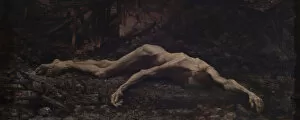Book Of Job Collection (#3)
"The Book of Job: A Tale of Trials and Triumphs" In the depths of human suffering, the story of Job resonates through time
All Professionally Made to Order for Quick Shipping
"The Book of Job: A Tale of Trials and Triumphs" In the depths of human suffering, the story of Job resonates through time. From ancient frescoes to intricate engravings, artists have captured the essence of this biblical narrative. A pencil outline brings to life "The Friends of Job, " a scene attributed to Taddeo Gaddi in 1845. The delicate strokes reveal the companionship and support that Job received during his trials. Another painting from around 1514 portrays "The Prophet Job" himself, his face etched with both pain and resilience. This masterpiece captures the inner strength that enabled him to endure unimaginable hardships. An engraving titled "Anglo Saxon men in tunica and Job in coaxalia" transports us back to 1796, showcasing how different cultures interpreted this timeless tale. It highlights their attire while emphasizing Job's central role as a symbol of perseverance. Yet not all depictions are serene; some delve into darker moments. In "Massacre of the children of Job, " a chromolitho reveals unspeakable tragedy but also reminds us that even amidst sorrow, hope can emerge. "Dick the Dustman, " an engraving capturing everyday life, shows how ordinary people relate to this extraordinary story. It reflects on how individuals find solace within its pages when facing their own struggles. Georg Pencz's engraving depicts "The Persecution of Job, " illustrating his unwavering faith despite relentless tormentors seeking his downfall. It serves as a reminder that steadfastness can overcome adversity. Engraved scenes like "Driving away the Ass of the Fatherless" shed light on social injustice faced by vulnerable members of society—Job's plight mirroring those who suffer today due to exploitation or neglect. Through another engraving entitled "Eastern Reapers reposing during the Heat of Day, " we witness respite amid hardship—a testament to finding moments of peace amidst life's toil.












